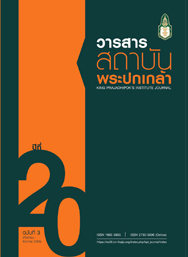Human Rights and the Constitution-Making in Thailand
Main Article Content
Abstract
This article commences with a brief history of Thailand’s constitutional developments of human rights. It argues that ever since the beginning of the Siamese Revolution in B.E.2475 (AD1932), Thailand’s construct of human rights norms is strongly aligned with western culture. Hence, the first constitution under the Temporary Charter B.E.2475 (AD1932) recognizes the right to vote. Specifically, this article considers the influences of western construct of human rights that translate into the constitutions. It also argues that international documents, especially the Universal Declaration of Human Rights that exist in the early days of Thailand’s constitutional development period provided the greatest influence on the shaping of Thailand’s constitutional human rights regime today. Recent developments highlight Thailand’s step towards inclusion of the right to development as documented in international environmental law and this is evident in the Constitution B.E.2540 (AD1997) and the recent constitution adoption which demonstrates Thailand’s desire to establish distinctively human rights norms that integrate local values and international human rights norms.
Article Details

This work is licensed under a Creative Commons Attribution-NonCommercial-NoDerivatives 4.0 International License.
@ 2020 King Prajadhipok's Institute The Government Complex Commemorating All Right Reserved.
References
ภาษาไทย
นครินทร์ เมฆไตรรัตน์. (2553). การปฏิวัติสยาม พ.ศ. 2475. นนทบุรี: ฟ้าเดียวกัน.
บวรศักดิ์ อุวรรณโณ. (2546). ศาลรัฐธรรมนูญตามรัฐธรรมนูญแห่งราชอาณาจักรไทย พ.ศ. 2540. วารสารสถาบันพระปกเกล้า, 1(1), 33–56.
ปวริศร เลิศธรรมเทวี. (2558). หลักและทฤษฎีสิ่งแวดล้อมในกฎหมายระหว่างประเทศ. วารสารนิติศาสตร์ มหาวิทยาลัยธรรมศาสตร์, 44(2), 443-467.
ปวริศร เลิศธรรมเทวี. (2561ก). การนำประเพณีในการปกครองระบอบประชาธิปไตยอันมีพระมหากษัตริย์ทรงเป็นประมุขมาใช้ในการพิจารณาวินิจฉัยคดีรัฐธรรมนูญ. กรุงเทพฯ: สำนักงานศาลรัฐธรรมนูญ.
ปวริศร เลิศธรรมเทวี (2561ข). ประชาคมเศรษฐกิจอาเซียนกับระบบกฎหมายไทย. กรุงเทพฯ: วิญญูชน.
ปวริศร เลิศธรรมเทวี. (2561ค). ประเพณีทางรัฐธรรมนูญ. กรุงเทพฯ: นิติธรรม.
พระพรหมคุณาภรณ์ (ประยุทธ์ ปยุตฺโต). (2556). การพัฒนาที่ยั่งยืน. กรุงเทพฯ: สำนักพิมพ์มูลนิธิโกมลคีมทอง.
มุนินทร์ พงศาปาน. (2562). ระบบกฎหมายซิวิลลอว์ : จากกฎหมายสิบสองโต๊ะสู่ประมวลกฎหมายแพ่งและพาณิชย์. กรุงเทพฯ: วิญญูชน.
วรรณไวทยากร วรวรรณ (พระเจ้าวรวงศ์เธอ กรมหมื่นนราธิปพงศ์ประพันธ์). (2511). ประวัติรัฐธรรมนูญไทย ฉบับแรก พ.ศ. 2475 ถึงฉบับปัจจุบัน. กรุงเทพฯ: โรงพิมพ์ประจักษ์วิทยา.
วิษณุ เครืองาม. (2530). กฎหมายรัฐธรรมนูญ. กรุงเทพฯ: นิติบรรณาการ.
ภาษาอังกฤษ
Boyle, Alan. (2012). Human Rights and the Environment: Where Next?. The European Journal of International Law, 23(3), 613-642.
Christian, Tomuschat. (1995). The United Nations at Age Fifty: A Legal Perspective. The Netherlands: Martinus Nihjhoff Publisher.
Clayton, Peter A. (1994). Chronicle of the Pharaohs: The Reign-by-Reign Record of the Rulers and Dynasties of Ancient Egypt. London: Thames and Hudson.
Figes, Orlando. (2014). Revolutionary Russia, 1891–1991. London: Pelican Book.
Freeman, Michael. (2002). Human Rights: An Interdisciplinary Approach. Malden, MA, The United States: Polity Press.
Hamidullah, Muhammad. (1975). The First Written Constitution in the World: An Important Document of the Time of the Holy Prophet. Lahore, Pakistan: Ashraf Press.
Hazell, Robert & Melton, James. (Eds). (2015). Magna Carta and its Modern Legacy. Cambridge: Cambridge University Press.
Hunter, David, Salzman, James & Zaelke, Durwood. (2002). International Environmental Law and Policy. Washington D.C.: Foundation Press.
Jolowicz, H.F. (1952). Historical Introduction to the Study of Roman Law. Cambridge: Cambridge University Press.
Lauren, Paul Gordon. (2003). Philosophical Visions: Human Nature, Natural Law, and Natural Rights. Pennsylvania: University of Pennsylvania Press.
Markiewicz, Tomasz. (2008). Bocchoris the Lawgiver–or was He Really?. Journal of Egyptian History, 1(2), 309–330.
Melton, James & Hazell, Robert. (2015). Magna Carta … Holy Grail?. In Robert Hazell & James Melton (Eds), Magna Carta and its Modern Legacy (pp. 3-22). Cambridge: Cambridge University Press.
Review: The Code of Hammurabi’ (1904). The American Journal of Theology, 8(3), 601–609.
Roth, Martha T. (1995). Law Collections from Mesopotamia and Asia Minor. Georgia, Atlanta: Scholar Press.
Sajo, Andras. (Ed). (2006). Militant Democracy. Utrecht, The Netherlands: Eleven International Publishing.
Sands, Philippe. (2003). Principles of International Environmental Law. New York: Cambridge University Press.
Seymour, Charles. (1916). The Diplomatic Background of the War. New Haven: Connecticut, Yale University Press.
Shelton, Dinah L. (2007). An Introduction to the History of International Human Rights Law. George Washington University Legal Studies Research Paper No. 346. Washington D.C.: George Washing University.
Stahn, Carsten. (2010). The Law and Practice of International Territorial Administration: Versailles to Iraq and Beyond. New York: Cambridge University Press.
Steiner, Henry J. & Alston, Philip. (2000). International Human Rights in Context: Law, Politics, Morals. Oxford: Oxford University Press.
Vasak, Karel. (1977). Human Rights: A Thirty-Year Struggle: The Sustained Efforts to give Force of law to the Universal Declaration of Human Rights. UNESCO Courier, 30(11), 29-32.


